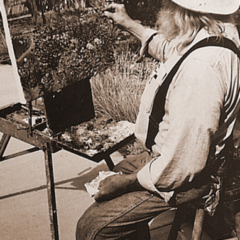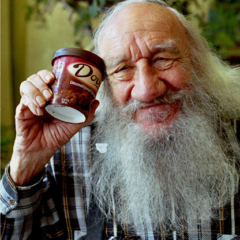Full Length Rockey Biography
= = =
Born in Baltimore in 1932, Charles Rockey came to Colorado at age 5 when his father, a career Naval officer and Annapolis graduate, contracted tuberculosis and was sent to Denver’s Fitzsimmon’s Army Hospital for treatment.
The family settled in Marshdale Park, a tiny mountain community near Evergreen. Rockey says it was a beautiful locale, but a tough place to grow up.
“I was a city kid suddenly thrown into the company of tough country kids who, at age 13, already had five-o’clock shadows and had been plowing fields since they could walk,” he recalled. “Until the last year or so of high school, I was an outcast and source of ridicule.”
The experience permanently stamped Rockey’s personality, instilling a lifelong sympathy for anyone who, being different in one way or another, isn’t accepted and doesn’t fit in.
He found solace through art and a Thoreauvian love of nature that led him to hike, climb and roam the mountainsides every chance he got. He says he “fell into” art out of desire to capture and express his communion with nature.
“Art was my saving grace,” he recalls. “It was my way of claiming legitimacy. It was how I overcame the feeling of being on the outside. To this day, I kind of connect to the world through my art.”
Graduating from Evergreen High School in 1950, Rockey spent a disastrous semester at the University of Colorado — living in a fraternity and putting far less effort into classes than into partying at Tulagi’s, known at the time for selling more draft beer than any other college tavern in the United States.
When he refused to return to C.U. for the spring semester, his dad cut off financial support. Rockey’s response was to finally do what he wanted above all else: head east to study art at the Art Institute of Chicago.
Supporting himself by loading freight trains all day, he attended classes at night. “I absolutely loved it,” he remembers. “For the first time in my life, I was able to study art seriously in the company of committed artists.”
He also reveled in “la vie de Bohme,” paying $35 a month for a room in a derelict building that the city had condemned. “We had gas, but no lights or hot water,” he recalls. “We lit candles when it got dark, and I rigged up some copper tubes over a stove burner to get tepid water for baths.”
He remembers this interim as “a free, wild and crazy time. We had some truly memorable parties where we talked until dawn, drank all night and painted on the walls. I could have lived that life forever.”
Life, however, took a more sober turn when he got married and moved into a “nicer, more normal” apartment. Acquiescing to ongoing, intense pressure from his father to “give up all this art silliness, get serious about life and become a man,” Rockey enlisted in the Marines for a two-summer platoon leader’s class that would culminate in a second lieutenant’s commission.
In the year intervening between the first and second summer, however, Rockey’s knees went bad. He was given an honorable discharge and went back to school full-time. Things looked pretty settled — at which point Fate exercised some editorial powers and turned his life Kafkaesque.
“Here I was — married, going to school, discharged from the Marines — and I got a draft notice from the Army ordering me to report to such-and-such a place for induction,” he explained. “It was ridiculous.”
He showed up at the appointed time and place fully intending to straighten the matter out and return home by lunchtime. The Korean War was raging though, the United States was getting its tail kicked, and no wanted to hear anything about any honorable discharge, college or marriage.
“Before I knew it,” he says, distress and disbelief audible in his voice, “I was being marched off to the train station along with everyone else, without so much as a toothbrush or change of clothes. I had to call my wife from the station to tell her I’d be gone for two years. To this day, I can’t believe it happened. I still have nightmares about it.”
He tried to get sent to Europe — “At least I’d get to see the world a bit,” he says — but was stationed at Fort Carson for what he describes as “two of the worst years of his life.”
For one, his wife disappeared without a word, prompting him to go AWOL in an unsuccessful attempt to find her.
For another, Rockey and the military are far from soulmates. “I’m not the military type,” he said, “and the commanding officer was a gung-ho maniac who got off on calling us out at 3 a.m. to harangue us from the top of his jeep about being good soldiers.”
Things improved a little toward the end of his Fort Carson stint when “Gung-Ho” was succeeded by “a levelheaded, basically good guy.” The new commander, it turns out, was none other than Robert Isaac, a West Point grad who would go on serve as mayor of Colorado Springs from 1979 to 1997.
The teacher
Following his discharge, Rockey got married a second time and acquired an M.A. in Art Education at Ohio State.
A job in Chicago at a school for military dependents segued into a job heading up a crafts program at Fort Carson, which transitioned into a 25-year teaching career in District 11, most of it at North Junior High.
Rockey recalls these years with a mixture of fondness and trauma.
By all accounts, he was an outstanding teacher — good with kids, patient with and sympathetic to the outsider mavericks that didn’t “fit in.”
“I wanted to make my students realize that art is the most important class they’d ever take,” he explains. “I was less concerned with teaching them to be artists than with teaching them to be artistic — to really pay attention, to care. In my view, artistry is a basic life skill, a tool for problem-solving, a way of living life. It doesn’t matter whether you’re a bricklayer, mechanic or bank robber — if you bring attention and care to what you do, if you do it with finesse and class, that’s your art.”
Recalling his years of being an outsider at their age, Rockey devoted himself to reaching the kids who were hardest to reach. “I’d get all the last-chance kids no one else would take,” he says.
“I put all my energies into figuring ways to reach them and help them link up to life,” he said. “I would begin with a surefire success project that any student could perform, a project that would introduce him to artistry instead of convince him that it wasn’t in the cards for him. We’d all bask in his feeling of accomplishment. And then, slowly, I’d expose him to more challenging projects to increase his experience of reward.”
Rockey, meanwhile, never gave his students an assignment that he didn’t do himself, too. Some of his most beautiful and memorable works — a number of which will be on display at the upcoming exhibit — are projects that he did in class in company with his students.
One such work was inspired when he was assigned a student whose face had been terribly disfigured by a fire.
“None of the kids would interact with him,” he said, “so I came up with the idea a ‘double-image’ work wherein first glance reveals one thing, but closer inspection reveals something more interesting. The idea was to show the kids how there are different ways to look at things, and that surface appearance doesn’t hold what’s most interesting.”
As a way of imparting this lesson, Rockey created a double-image he entitled “Azalea Fairy” wherein first glance reveals a bunch of azaleas, but closer inspection reveals a libidinous nymph in a stunning state of undress.
The lesson apparently took. The disfigured kid went on that year to be elected class president by his fellow students.
The highlight of his teaching career, said Rockey, was “the privilege of having all four of my kids — Ivan, Noah, Sarah and Hannah — as students during their junior high years. They all got A’s. I was hoping one of them would eventually end up going out to sit with me and paint landscapes, but no such luck.”
Eventually, however, the classroom left Rockey frazzled and burnt out. “I love to teach, and I gave it everything I had,” he said, “but I didn’t know what I was getting myself into. Anybody who thinks teachers have it easy doesn’t have a clue. It’s one of the most difficult jobs in the world.
“Those were tough, traumatic years,” he added. “They taught me humility, survival tactics and how to derive good from extremely traumatic events.”
Burnt out by teaching, left devastated by an increasing problem with alcoholism and a divorce that turned his life upside down, Rockey acted on a chance to take early retirement in 1972, moved to Manitou Springs and, for the first time in his life, devoted himself solely to art.








